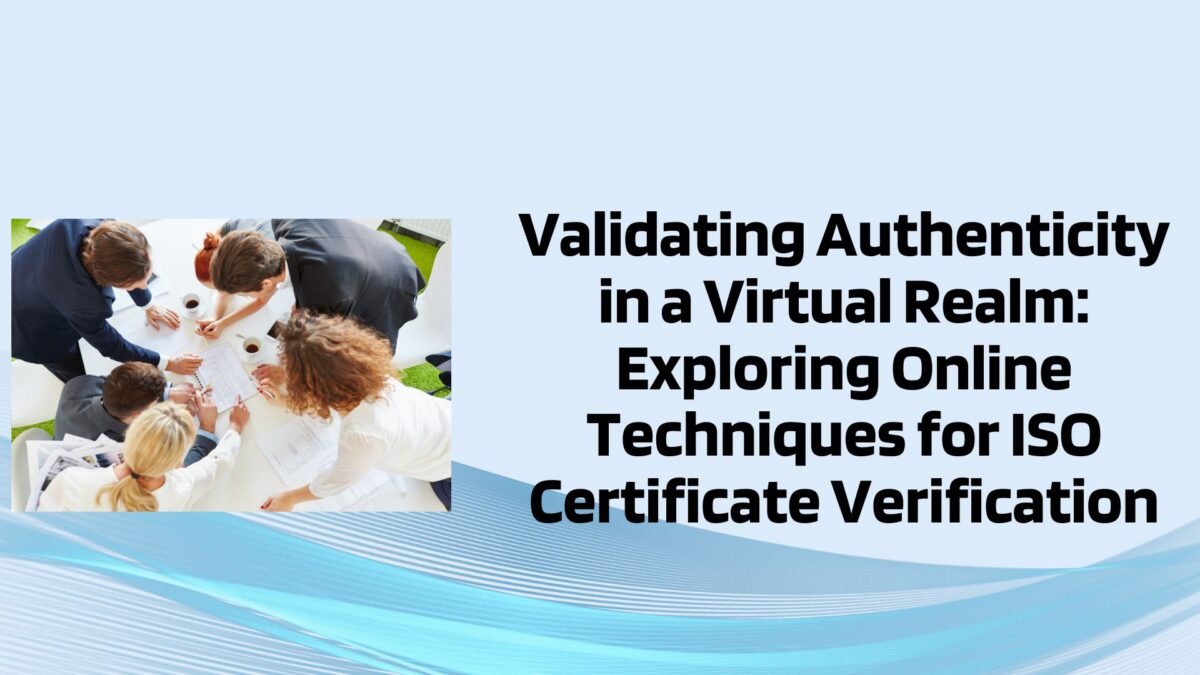Validating Authenticity in a Virtual Realm: Exploring Online Techniques for ISO Certificate Verification

In an era dominated by digital landscapes and virtual transactions, the need for trust and authenticity has taken center stage. This necessity extends into the realm of certifications and standards, particularly within the International Organization for Standardization (ISO) framework. As businesses and consumers increasingly rely on ISO certifications to ascertain quality, authenticity, and compliance, the veracity of these certificates becomes paramount. In response to the growing digitization of records and certificates, the development of robust online methods for ISO certificate verification has become an imperative pursuit.
Understanding the Significance of ISO Certification
ISO standards serve as the bedrock for ensuring quality, safety, and efficiency across diverse industries worldwide. These certifications validate an organization’s commitment to meeting specific criteria, whether in quality management, environmental responsibility, information security, or other domains. The credibility of these certifications is crucial for businesses engaged in global trade, ensuring confidence among partners, suppliers, and consumers.
The Challenge in Ensuring Authenticity
Traditionally, the verification process for ISO certificates relied heavily on physical documents, paper trails, and manual inspections. However, the digital revolution has necessitated a shift towards more efficient and reliable online verification methods. The challenge lies in adapting verification processes to the digital age while maintaining robust security measures that prevent fraud or manipulation.
Embracing Technology for Online Verification
Advancements in technology offer a myriad of solutions to address the authenticity conundrum in the digital realm. Blockchain, for instance, provides an immutable ledger system that can securely store and validate ISO certificates. Each certification is recorded as a block, ensuring transparency and tamper-proof verification.
Moreover, QR codes and unique identifiers embedded within certificates allow instant access to online databases, enabling real-time verification. This approach not only enhances accessibility but also provides a quick and reliable method for stakeholders to validate ISO certifications.
Leveraging Machine Learning and AI for Enhanced Verification
Machine learning algorithms and artificial intelligence (AI) systems have revolutionized data analysis. These technologies can be employed to scrutinize patterns, detect anomalies, and verify the authenticity of ISO certificates. By analyzing vast datasets and cross-referencing information, AI-driven systems can swiftly identify discrepancies, thus bolstering the verification process.
Collaborative Efforts and Standardization
Ensuring the efficacy of online verification methods requires collaborative efforts among stakeholders. Establishing standardized protocols and guidelines for online ISO certificate verification is imperative. This entails the involvement of ISO regulatory bodies, technology experts, certification agencies, and businesses to create a unified framework that guarantees authenticity.
Addressing Security and Privacy Concerns
While online verification offers convenience, it also raises concerns regarding data security and privacy. Implementing robust encryption, secure databases, and compliance with data protection regulations are critical to safeguard sensitive information during the verification process.
The Road Ahead: Evolution and Adaptation
The landscape of ISO certificate verification continues to evolve as technology advances. Continuous innovation and adaptation are crucial to staying ahead of fraudulent practices. Embracing emerging technologies, refining verification processes, and fostering collaboration will fortify the authenticity of ISO certifications in the digital age.
Deep Dive into Online Methods for ISO Certificate Verification
Blockchain’s Role in Ensuring Immutable Records
Blockchain technology, with its decentralized and immutable nature, offers a groundbreaking solution for verifying ISO certificates. The implementation of blockchain creates an unalterable record of certifications, accessible to all authorized parties. Each certificate issued gets timestamped and linked to previous records, rendering any tampering or alteration immediately evident. This not only enhances trust but also simplifies the verification process, reducing the reliance on intermediaries and manual checks.
Enhanced Accessibility with QR Codes and Unique Identifiers
Integration of QR codes and unique identifiers within ISO certificates simplifies the verification process for stakeholders. By scanning a QR code or inputting a unique identifier into a dedicated online platform, users can instantly access a certificate’s authenticity status. This method provides real-time validation, offering convenience and prompt assurance to concerned parties.
Artificial Intelligence: A Tool for Robust Validation
The incorporation of AI-driven algorithms significantly fortifies the verification process. AI systems can analyze historical data, flag irregularities, and perform intricate pattern recognition, enabling swift identification of fraudulent certificates. Machine learning models can continuously evolve, learning from past discrepancies to enhance their accuracy in detecting inconsistencies or forged documents, thereby strengthening the validation process.
The Importance of Interconnected Databases and Interoperability
Creating interconnected databases that allow seamless information sharing among certification bodies, regulatory agencies, and businesses is pivotal. Standardizing data formats and fostering interoperability between different systems ensures a synchronized approach to certificate verification. This interconnectedness reduces redundancy, streamlines the verification process, and enhances the overall reliability of the system.
Data Security Measures: Safeguarding Confidentiality
Preserving the confidentiality and security of sensitive data during online verification is paramount. Employing encryption techniques, stringent access controls, and robust cybersecurity measures help mitigate potential risks associated with data breaches or unauthorized access. Compliance with stringent data protection regulations such as GDPR or HIPAA adds an extra layer of assurance regarding data security.
Continuous Improvement through Feedback Mechanisms
Implementing feedback mechanisms allows stakeholders to report suspicious certificates or issues encountered during the verification process. This facilitates continuous improvement, enabling swift resolution of discrepancies and refining the verification protocols. Encouraging feedback fosters transparency and trust among stakeholders, reinforcing the credibility of the verification process.
Education and Awareness: Empowering Stakeholders
Educating stakeholders about the significance of authentic certifications and the verification methods available is vital. Creating awareness programs that elucidate the importance of ISO standards, the verification process, and the role of online methods in ensuring authenticity fosters a knowledgeable and vigilant community. Empowering stakeholders with information encourages active participation in maintaining the integrity of ISO certifications.
Note: You Can Apply for ISO 50001 Certification
Conclusion
In a digital ecosystem, ensuring the credibility and authenticity of ISO certificates demand a dynamic and adaptable approach. By leveraging cutting-edge technologies, fostering collaboration, and prioritizing security, the development of online methods for ISO certificate verification becomes not just a necessity but a testament to the commitment to quality, trust, and reliability in an interconnected world.
As we navigate this terrain, the evolution of online verification methods will not only reinforce the integrity of ISO certifications but also lay the groundwork for a future where authenticity remains a cornerstone of global trade and industry standards.










